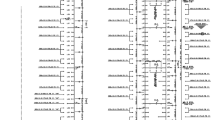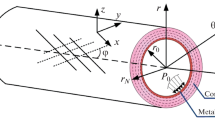Abstract
Recently, it has been found that submarine pressure hulls constructed from fiber-reinforced multilayers have great potential to replace classical metallic ring-stiffened pressure hulls. The strength and stability of these structures are the most important functional requirements and should be considered in any design procedure. This study aimed to optimize the strength and buckling stability of elliptical composite deep-submerged pressure hulls using two different filament winding patterns, namely geodesic and planar. The numerical modeling of the pressure hull under hydrostatic was carried out using the Finite Element Method (FEM) in ABAQUS using Python script and a damage model written as a User MATerial (UMAT) Subroutine. Puck failure criterion was chosen for failure prediction. The results suggest that both buckling and the static material failure should be considered in the design of a composite pressure hull. Moreover, it was shown that the optimum pressure hull has a geodesic filament winding pattern with a/b (the ratio between two diameters) =1.2 and the winding angle of 45°. Based on the progressive failure criterion, for such an optimum design, failure initiates at an applied load of 28.6 MPa and the pressure hull withstands to 40.3 MPa.


















Similar content being viewed by others
References
Pattison, "Design of Submarine Structures," Bristol 2001
Smith, C.S.: Design of Marine Structures in Composite Materials. Elsevier, London (1990)
Mouritz, A.P., Gellert, E., Burchill, P., Challis, K.: Review of advanced composite structures for naval ships and submarines. Compos. Struct. 53(1), 21–42 (2001)
Almeida Jr., J.H.S., Faria, H., Marques, A.T., Amico, S.C.: Load sharing ability of the liner in type III composite pressure vessels under internal pressure. J. Reinf. Plast. Compos. 33(24), 2274–2286 (2014)
Tafreshi, A.: Delamination buckling and postbuckling in composite cylindrical shells under combined axial compression and external pressure. Compos. Struct. 72(4), 401–418 (2006)
Mistry, J., Gibson, A., Wu, Y.-S.: Failure of composite cylinders under combined external pressure and axial loading. Compos. Struct. 22(4), 193–200 (1992)
Gheshlaghi, R.M., Hojjati, M.H., Daniali, H.R.M.: Analysis of composite pressure vessels. In: Gdoutos, E.E. (ed.) Fracture of Nano and Engineering Materials and Structures: Proceedings of the 16th European Conference of Fracture, Alexandroupolis, Greece, July 3–7, 2006, pp. 335–336. Springer Netherlands, Dordrecht (2006)
Błachut, J.: Buckling of externally pressurized shallow spherical caps from composites. Mech. Adv. Mater. Struct. 18(2), 96–105 (2011)
Mian, H.H., Wang, G., Dar, U.A., Zhang, W.: Optimization of composite material system and lay-up to achieve minimum weight pressure vessel. Appl. Compos. Mater. 20(5), 873–889 (2013)
Walker, M., Smith, R.E.: A technique for the multiobjective optimisation of laminated composite structures using genetic algorithms and finite element analysis. Compos. Struct. 62(1), 123–128 (2003)
Rao Yarrapragada, K., Krishna Mohan, R., Kiran, B.V.: Composite pressure vessels. International Journal of Research in Engineering and Technology. 1(4), 597–618 (2012)
Pelletier, J.L., Vel, S.S.: Multi-objective optimization of fiber reinforced composite laminates for strength, stiffness and minimal mass. Comput. Struct. 84(29), 2065–2080 (2006)
Gomes, H.M., Awruch, A.M., Lopes, P.A.M.: Reliability based optimization of laminated composite structures using genetic algorithms and artificial neural networks. Struct. Saf. 33(3), 186–195 (2011)
Marín, L., Trias, D., Badalló, P., Rus, G., Mayugo, J.: Optimization of composite stiffened panels under mechanical and hygrothermal loads using neural networks and genetic algorithms. Compos. Struct. 94(11), 3321–3326 (2012)
Topal, U., Uzman, Ü.: Multiobjective optimization of angle-ply laminated plates for maximum buckling load. Finite Elem. Anal. Des. 46(3), 273–279 (2010)
Lee, G.-C., Kweon, J.-H., Choi, J.-H.: Optimization of composite sandwich cylinders for underwater vehicle application. Compos. Struct. 96, 691–697 (2013)
Bakshi, K., Chakravorty, D.: First ply failure study of thin composite conoidal shells subjected to uniformly distributed load. Thin-Walled Struct. 76, 1–7 (2014)
Liang, C.-C., Chen, H.-W., Jen, C.-Y.: Optimum design of filament-wound multilayer-sandwich submersible pressure hulls. Ocean Eng. 30(15), 1941–1967 (2003)
Zu, L., Koussios, S., Beukers, A.: Shape optimization of filament wound articulated pressure vessels based on non-geodesic trajectories. Compos. Struct. 92(2), 339–346 (2010)
Messager, T., Pyrz, M., Gineste, B., Chauchot, P.: Optimal laminations of thin underwater composite cylindrical vessels. Compos. Struct. 58(4), 529–537 (2002)
Maalawi, K.: Optimal buckling design of anisotropic rings/long cylinders under external pressure. J. Mech. Mater. Struct. 3(4), 775–793 (2008)
Almeida Jr., J.H.S., Ribeiro, M.L., Tita, V., Amico, S.C.: Damage and failure in carbon/epoxy filament wound composite tubes under external pressure: experimental and numerical approaches. Mater. Des. 96, 431–438 (2016)
Almeida Jr., J.H.S., Ribeiro, M.L., Tita, V., Amico, S.C.: Damage modeling for carbon fiber/epoxy filament wound composite tubes under radial compression. Compos. Struct. 160, 204–210 (2017)
Park, J.-S., Hong, C.-S., Kim, C.-G., Kim, C.-U.: Analysis of filament wound composite structures considering the change of winding angles through the thickness direction. Compos. Struct. 55(1), 63–71 (2002)
Liang, C.-C., Chen, H.-W., Wang, C.-H.: Optimum design of dome contour for filament-wound composite pressure vessels based on a shape factor. Compos. Struct. 58(4), 469–482 (2002)
W. E. Howard, "Design and Analysis Tools for Filament-Wound Composite Pressure Vessels with Elliptical Domes," 2001
Soden, P., Kaddour, A., Hinton, M.: Recommendations for designers and researchers resulting from the world-wide failure exercise. Compos. Sci. Technol. 64(3), 589–604 (2004)
Puck, A., Schürmann, H.: Failure analysis of FRP laminates by means of physically based phenomenological models. Compos. Sci. Technol. 58(7), 1045–1067 (1998)
Knops, M.: Analysis of Failure in Fiber Polymer Laminates: the Theory of Alfred Puck. Springer Science & Business Media (2008)
Knops, M., Bögle, C.:Gradual failure in fibre/polymer laminates. Compos. Sci. Technol. 66(5), 616-625 (2006).
Puck, A., Schürmann, H.: Failure analysis of FRP laminates by means of physically based phenomenological models. Compos. Sci. Technol. 62(12), 1633–1662 (2002)
Author information
Authors and Affiliations
Corresponding author
Additional information
Publisher’s Note
Springer Nature remains neutral with regard to jurisdictional claims in published maps and institutional affiliations.
Rights and permissions
About this article
Cite this article
Molavizadeh, A., Rezaei, A. Progressive Damage Analysis and Optimization of Winding Angle and Geometry for a Composite Pressure Hull Wound Using Geodesic and Planar Patterns. Appl Compos Mater 26, 1021–1040 (2019). https://doi.org/10.1007/s10443-019-09764-8
Received:
Accepted:
Published:
Issue Date:
DOI: https://doi.org/10.1007/s10443-019-09764-8




